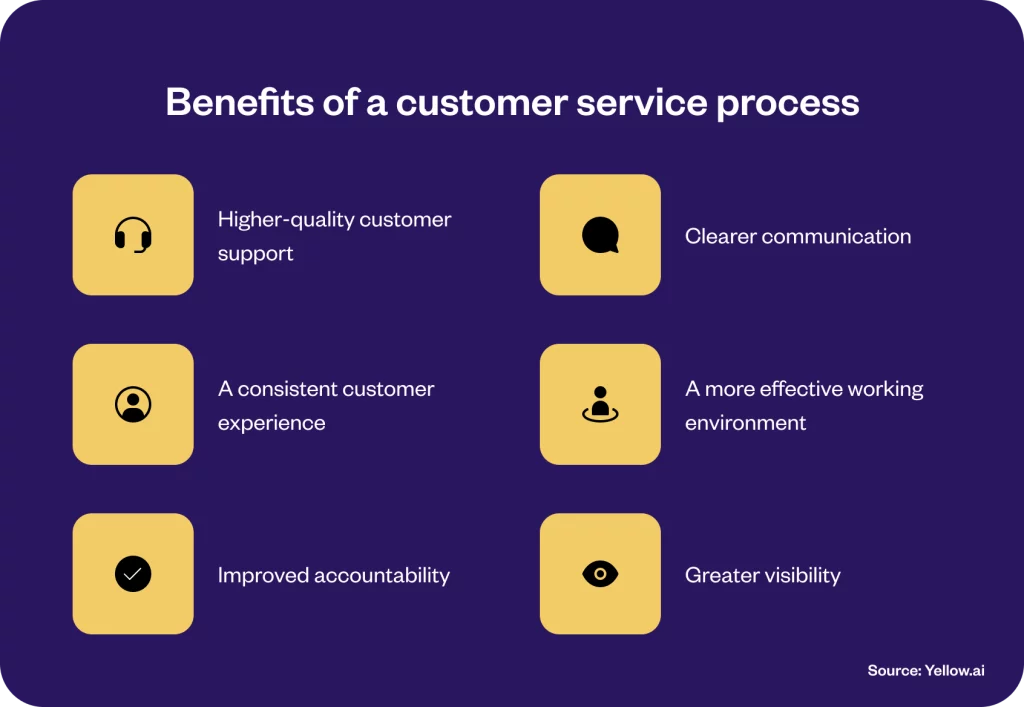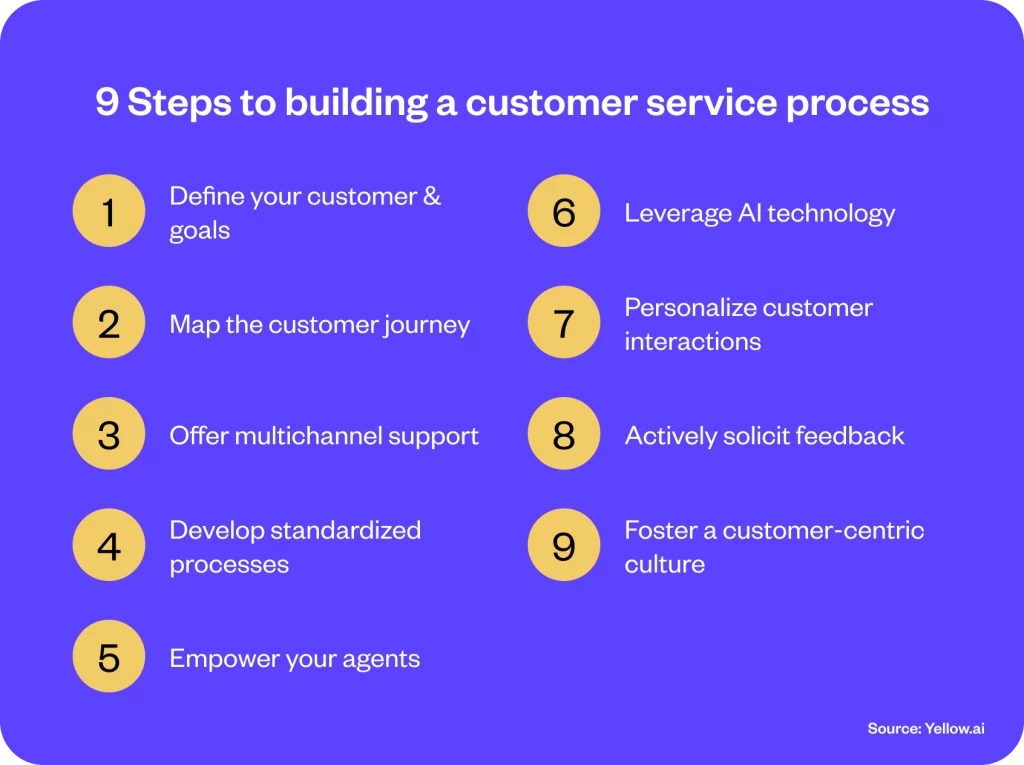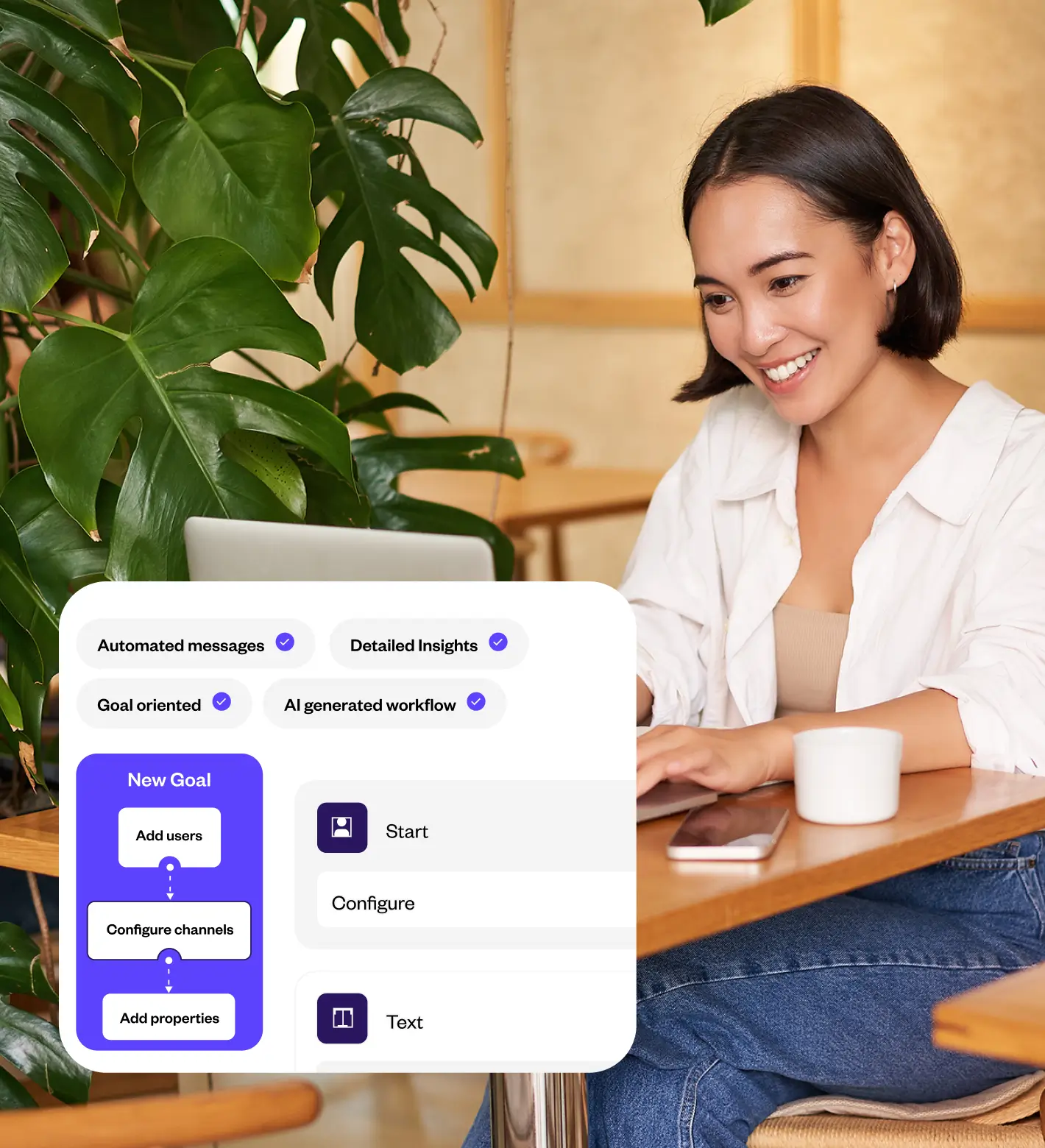Executive summary
Navigating the complex maze of customer service in today’s business climate is both an art and a science. This blog takes you on a deep dive into constructing a customer service process that resonates in 2024’s evolving market. We’re talking about a blueprint that tackles customer queries and transforms them into meaningful interactions and lasting impressions. From decoding customer psychology to leveraging cutting-edge tools, this guide offers an arsenal of strategies for businesses ready to redefine their customer service paradigms and set new benchmarks in customer satisfaction.
Picture this: It’s a regular Tuesday, and your customer service team faces the usual influx of queries. But here’s the twist – every interaction is an episode of understanding, adapting, and exceeding expectations. That’s the new norm in 2024’s customer service saga. With research indicating that top-notch customer service can sway consumer spending by up to 17%, the stakes have never been higher.
Yet, creating a customer service process that consistently delivers excellence is more intricate than it appears. It’s not just about answering calls or replying to emails. It’s about building a support workflow as dynamic and varied as the customers it serves. We’re moving beyond the age-old scripts and reactive strategies. Instead, we’re stepping into an era where each customer interaction is a golden opportunity to strengthen bonds and build brand loyalty. This blog is your compass in crafting a customer service process that’s empathetic, innovative, and, above all, human. Get ready to explore the blueprint for a customer service strategy that solves problems and also builds enduring customer relationships.
Related must-reads:
- Customer service automation – A full guide
- 10 Bad customer service examples (How to fix them)
- 12 Customer service metrics to measure in 2024
- Should your business outsource customer service?
What is the customer service process?
The customer service process in today’s business world is just like a roadmap guiding every interaction with clients. It’s about crafting a journey where each step from query to resolution is handled with precision and care, tailored to the unique needs of every customer.
The customer service process is not merely about reacting to customer needs but anticipating them. It’s a strategic framework that encompasses everything from the initial contact to the final resolution and follow-up. For instance, consider a restaurant that does not limit its customer service to just responding to a diner’s complaint about a dish. Instead, it follows up with a personalized email offering a complimentary meal. This proactive approach turns a one-time issue into an opportunity for relationship-building.
A well-defined customer service process is the difference between chaos and harmony. Without it, businesses risk inconsistent service quality, which can lead to customer dissatisfaction and churn. On the flip side, a robust process empowers teams with clarity and direction. An example of this is a tech company that uses a structured approach to handle service outages swiftly. It ensures that customers are regularly updated and their concerns are addressed, thus maintaining trust even in challenging situations.
Today, customer service is way more than just a support function. Instead, it’s a critical part of the customer experience. A customer-centric service process goes beyond solving problems – it’s about understanding and valuing the customer’s perspective. This approach could involve using tools like sentiment analysis to gauge customer emotions and tailor responses accordingly. It ensures that each interaction is a meaningful conversation.
Why is a customer service process essential?
Imagine your customer service team as architects and builders. It crafts bridges that connect your business to your customers. A solid customer service process lays down the planks for these bridges, ensuring that each interaction is reliable and consistent. This reliability transforms a one-time buyer into a loyal customer. For example, when a customer reaches out with a concern, they are walking across this bridge, trusting that your team will guide them safely to a solution. Without a structured process, it’s like removing planks from this bridge – leaving customers feeling uncertain and unsupported.
A well-defined customer service process directly contributes to heightened customer satisfaction. When customers know what to expect and receive consistent, high-quality service, their trust and loyalty towards the brand strengthen. For instance, a retail company that has a clear process for handling returns and exchanges is more likely to retain customers as they feel confident and secure in their transactions. This trust is a valuable currency in the modern business landscape, where customer loyalty can be the deciding factor in a highly competitive market.
An established customer service does more than just benefit customers. It also streamlines your internal operations. It’s like having a well-oiled machine where every part works in sync, leading to improved efficiency and productivity. With clear guidelines and procedures, your customer service team can handle inquiries and issues more swiftly and effectively. As a result, it reduces response times and increases the overall throughput of your support system. This efficiency boosts the morale of your team and also positively impacts your bottom line, as you can handle more customer interactions without compromising on quality.
Benefits of a customer service process
Establishing a comprehensive customer service process is more than addressing customer issues. It’s about laying the foundation for a system that ensures quality, clarity, consistency, efficiency, accountability, and visibility in customer interactions. For businesses, this means paving the way for a more connected and satisfied customer base in the future.

Let us understand the benefits of having a customer service process in place.
1. Higher-quality customer support
A well-structured customer service process is a game-changer in elevating the quality of support provided. Implementing a strong customer service process is like setting the stage for a top-notch performance. Every step is carefully crafted to ensure customer inquiries are met with precision and care. Consider a tech support team equipped with a detailed guide for troubleshooting. Besides elevating customer experience, it also builds a reputation for your brand as one that delivers effective solutions.
For instance, a customer who is facing an issue with an online transaction is swiftly guided through a resolution. This quick resolution will leave them impressed with the prompt service. To achieve such a level of service, companies should regularly update their process guides and ensure continuous training for their staff.
Related reads:
- How to scale customer support in your organization?
- AI Agent Assist – Elevating customer support efficiency
- 10 Great customer service experience examples in 2024
2. Clearer communication
The clarity in communication is the cornerstone of successful customer interactions. A robust customer service process ensures that every team member is on the same page, thereby reducing misunderstandings and errors. It’s like having a clear, well-marked road map for customer interactions; every direction is precise, leading to fewer detours and quicker resolutions.
When communication is clear, the chances of misinterpretation or confusion plummet. For instance, a customer seeking information on a product feature receives a coherent and comprehensive response. That will add to the customer’s loyalty to your brand.
Businesses should invest in training their staff in effective communication and ensure that all customer-facing teams have access to updated information and guidelines.
3. A consistent customer experience
Consistency is vital in building customer trust. A consistent customer service approach reassures customers that they can expect the same high-quality experience every time they interact with your brand.
Whether a customer is interacting with a service agent or using a self-service portal, they experience the same level of attentiveness and detail. Businesses should implement standardized service protocols and monitor service quality across all channels to maintain consistent customer experience.
Related read:
- 10 Great customer service experience examples in 2024
- Customer experience in banking: Importance, examples, and trends for 2024
- Customer experience in retail: Strategies and the future of CX
- What is customer experience (CX) in healthcare?
4. A more effective working environment
A streamlined customer service process leads to a more efficient and organized work environment. It equips teams with clear guidelines, reducing the time spent on decision-making and increasing focus on delivering solutions.
This efficiency translates into quicker resolution times and higher customer and employee satisfaction levels. Businesses should focus on creating an organized and supportive work environment that empowers employees to deliver their best.
Related read: Employee experience: A complete guide for HR
5. Improved accountability
When a customer service process is in place, it’s easier to track performance and hold team members accountable for their actions. This accountability is crucial for maintaining service quality and for continuous improvement.
For example, if a customer’s issue is not resolved on time, it’s easier to trace back the steps and identify where the process faltered. Businesses should implement clear performance metrics and regular evaluations to ensure accountability.
6. Greater visibility
A defined customer service process offers greater visibility into the operations of your support team. This insight is invaluable for spotting trends, identifying areas for improvement, and making informed decisions.
By tracking metrics such as response times and customer satisfaction scores, you can gain a clear understanding of how your team is performing and where enhancements are needed. Leveraging data analytics tools can further refine this visibility.
9 Steps to building a customer service process
Creating an effective process is challenging yet fruitful. As a business, you must ensure that each step is in sync with customer needs and expectations. Let us look at nine crucial steps to build a customer service process that builds lasting connections with customers.

Step 1: Define your customer & goals
Understanding your audience: Begin by identifying who your customers are. Are they tech-savvy millennials or value-driven baby boomers? This understanding shapes your service approach.
Setting clear objectives: Then, align your customer service goals with your business vision. Whether it’s reducing response times or increasing customer satisfaction scores, clear goals provide direction.
For example, a software company might target reducing tech support resolution time by 30%, thereby enhancing customer satisfaction.
Here is how you can implement the step:
- Conduct surveys and research to understand customer demographics.
- Set achievable, measurable goals for your customer service team.
- Regularly review these goals to ensure alignment with customer expectations.
Step 2: Map the customer journey
Charting the path: Map out each stage of the customer journey, from discovery to post-purchase support. This map reveals critical touchpoints where you can make an impact.
Understanding pain points: Identify areas where customers might experience friction and proactively address these in your service process.
Example: An ecommerce store may notice that customers often have queries about shipping. They could proactively provide shipping information at various stages of the purchase process.
Here is how you can implement the step:
- Visualize the entire customer journey.
- Identify and improve touchpoints.
- Use customer feedback to refine the journey map continually.
Step 3: Offer multichannel support
Expanding your reach: Today’s digital-savvy customers expect to reach you through various channels – be it social media, email, or live chat. Offering multichannel support meets customers where they are.
Seamless experience: Ensure consistency across all channels for a seamless customer experience. That will ensure customer loyalty and enhance customer experience.
Example: A retail brand could integrate its CRM with social media platforms to provide quick and consistent responses to customer inquiries.
Here is how you can implement this step:
- Determine which channels your customers use most.
- Train your team to deliver uniform service across all platforms.
- Monitor and optimize the performance of each channel.
Related read: Omnichannel vs multichannel – What’s the difference?
Step 4: Develop standardized processes
Creating a playbook: Standardize responses and processes for common customer queries. A standardized process will ensure consistency and efficiency in customer service.
Training for excellence: Regular training based on these standardized processes keeps your team updated and ready to handle any situation.
Example: A telecom company could standardize procedures for addressing network issues, ensuring all customers receive a timely and consistent response.
Here is how you can implement this step:
- Document standard procedures and responses.
- Regularly update the team with any changes or new policies.
- Conduct training sessions to ensure everyone is on the same page.
Step 5: Empower your agents
Equipping for success: Empowering your agents with the right tools and information enables them to provide exceptional service.
Encouraging ownership: Allow agents some autonomy to make decisions. This empowerment leads to more personalized customer service.
Example: An agent at an airline’s customer service desk might be empowered to offer instant compensation for flight delays.
Here is how you can implement this step:
- Provide comprehensive training on products and services.
- Equip agents with the necessary tools and technology.
- Foster a culture of trust and responsibility.
Related read: AI agents: types, benefits, and examples
Step 6: Leverage AI technology
Enhancing with AI: Integrate AI-driven solutions like chatbots for routine inquiries, allowing human agents to focus on complex issues.
Balancing tech and touch: Use AI to enhance service quality while maintaining the human element in customer interactions.
Example: An online retailer uses chatbots to track order status while human agents handle return and refund queries.
Below are some points to consider when implementing this step:
- Identify areas where AI can improve efficiency.
- Ensure AI tools like chatbots are seamlessly integrated with human support systems.
- Continuously monitor and adjust AI systems for optimum performance.
Step 7: Personalize customer interactions
Creating unique experiences: Personalize interactions based on customer data. This approach shows customers that they are valued and understood.
Going beyond names: Personalization goes beyond just addressing customers by name; it’s about tailoring solutions and recommendations.
Example: A streaming service provides personalized show recommendations based on viewing history.
Here is how you can implement this step:
- Utilize customer data to tailor interactions.
- Train staff on effective personalization techniques.
- Use CRM systems to store and analyze customer information.
Step 8: Actively solicit feedback
Listening to the voice of customers: Actively seeking customer feedback shows that you value their opinions and are committed to improvement.
Turning feedback into action: Use feedback to make informed decisions about your service process and product offerings.
Example: A restaurant uses customer feedback to tweak its menu and improve service, leading to increased repeat business.
Here is how to implement this step:
- Use surveys and feedback tools post-interaction.
- Analyze feedback for insights and trends.
- Implement changes based on customer suggestions.
Step 9: Foster a customer-centric culture
Building a customer-first team: Embedding a customer-centric approach in your company’s culture ensures that every decision prioritizes customer satisfaction.
Leading by example: Management should exemplify customer-centric behaviors.
Example: A hotel’s management team regularly interacts with guests to understand their needs, setting a precedent for the staff.
Here is how you can implement it:
- Train and motivate employees to adopt a customer-first mindset.
- Recognize and reward customer-centric behaviors.
- Regularly communicate the importance of customer-centricity to the entire team.
How Yellow.ai can revolutionize your customer service process
Staying ahead in customer service is a necessity in this competitive business world. Yellow.ai is helping businesses do so by transforming the traditional customer service process into a dynamic, AI-driven experience. Integrating Yellow.ai’s sophisticated AI chatbot technology into your customer service arsenal can help you set a new standard in customer interactions.
Our state-of-the-art AI chatbots provide a seamless blend of efficiency and personalization. These bots understand and adapt to customer preferences and deliver solutions that are timely and also personalized. With capabilities to handle multiple queries across various channels, these bots offer a consistent quality of service, ensuring that no customer feels left behind.
Here’s how Yellow.ai redefines customer service:
- Intelligent automation: Yellow.ai’s chatbots are equipped with advanced AI and are capable of handling a wide range of queries. It means faster resolutions, reduced wait times, and a significant decrease in manual workload for customer service teams.
- Personalization at scale: By leveraging data analytics and AI, Yellow.ai chatbots offer personalized experiences to each customer, making interactions more meaningful and productive.
- Omnichannel support: Our platform ensures a seamless experience across various channels, be it social media, email, or web chat. Consistency in service, regardless of the medium, elevates customer satisfaction.
- 24/7 availability: With Yellow.ai, support is always on. Our AI bots are available round the clock, ensuring that customer inquiries are addressed at any time, enhancing overall service reliability.
- Real-time analytics and reporting: Gain valuable insights into customer interactions with real-time analytics. This data helps in refining strategies and improving service quality continuously.
Case studies: Real-world successes with Yellow.ai

Hyundai boosts revenue and improves customer service with AI automation
Explore how Yellow.ai’s automation led to ~1000 car sales, a 10% retail conversion rate, and over 1.4 million user impressions

Pelago reimagines customer experience with generative AI powered conversational AI agents
Within a mere six weeks of going live, Pelago not only onboarded over 5,000 users but also achieved a striking 50% deflection rate!
The final thoughts
The customer service landscape is ever-changing. Hence, businesses must continuously adapt to stay relevant and effective. By embracing innovative technologies and a customer-centric approach, businesses can meet and exceed customer expectations and build lasting relationships and trust.
Looking ahead, the future of customer service shines bright with possibilities. The integration of AI and human empathy, the personalization of customer interactions, and the relentless pursuit of excellence are the pillars upon which successful customer service strategies will be built. As we venture forward, let’s remember the ultimate goal behind each customer service process: to deliver service that doesn’t just satisfy but truly delights the customer.
Frequently asked questions (FAQs)
What are the key components of an effective customer service process?
An effective customer service process hinges on several core elements. Clear and empathetic communication is paramount. It’s essential to thoroughly understand customer needs and address them swiftly. Regular team training and constructive use of customer feedback can significantly enhance service quality. Remember, consistency and reliability in responses build trust and credibility.
How can technology be integrated into the customer service process?
Incorporating technology into customer service is about striking a balance. AI chatbots can efficiently handle routine inquiries, freeing up human agents for complex issues. Customer Relationship Management (CRM) systems are excellent for organizing and tracking interactions. Importantly, use analytics to gather insights and continuously refine your service strategies.
How do you measure the success of a customer service process?
The success of your customer service can be quantified through several key metrics. Pay close attention to customer satisfaction scores, the speed of your responses, and the effectiveness of your problem resolution. Regular evaluation of these metrics will illuminate your service strengths and areas needing improvement.
What role does customer feedback play in the service process?
Customer feedback is invaluable. It’s a direct line into your customers’ thoughts and experiences. Actively listening and responding to this feedback demonstrates that you value their input and are committed to evolving and improving your service to meet their needs.
How can a business create a customer-centric service process?
To create a customer-centric service process, start by placing customer needs at the forefront of your strategy. Personalize your interactions and make sure your responses are tailored to their specific issues. Cultivate a company culture where customer satisfaction is a top priority.
What are the challenges in maintaining a consistent customer service process?
Maintaining consistent customer service and customer interactions across various platforms is challenging. It involves adapting to different communication styles, keeping up with technological advancements, and ensuring uniform service quality. Regular training and a solid strategy can help overcome these challenges.
How can multichannel support be managed effectively?
Effectively managing multichannel support requires a seamless strategy across all platforms. Train your team to handle different modes of communication. Utilize technology to integrate and keep track of all customer interactions, ensuring no customer query falls through the cracks.




















